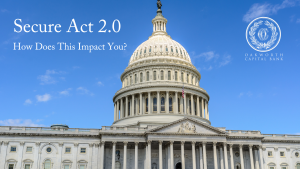Last week, while most people were enjoying some time off at the end of the year, SECURE ACT 2.0 was signed into law. If this all seems like déjà vu, you are correct because almost three years earlier to the day The SECURE Act was signed into law. There are many provisions in these laws that are designed to encourage retirement savings. But for the purposes of this blog post, I will only focus on a few of the changes that have the potential to be most impactful.
Changes to Required Minimum Distributions (RMDs)
The 2019 version of the SECURE Act was notable because it moved the RMD age from 70½ to 72, representing the first change since 1986. SECURE Act 2.0 changes the RMD age again. Specifically, the law states:
- Age 73 for any person who turns age 72 after Dec. 31, 2022
- Age 75 for any person who turns age 74 after Dec. 31, 2032
For person who are already receiving RMDs the penalty for not taking that RMD has been reduced from 50% to 25%. With another reduction to 10% possible if the mistake is corrected in a timely manner.
In 2024, the SECURE Act 2.0 will eliminate RMDs for Roth Accounts of qualified employer (Roth 401(k), Roth 403b, Roth 457(b), etc.) plans.
Roth Changes
One of the more significant changes brought about by the SECURE Act 2.0 pertains to Roth Accounts. Previously I mentioned the change to RMDs. Here are some other impactful changes:
- Creation of SIMPLE Roth IRAs and SEP Roth IRAs starting in 2023
- Ability for employers to make contributions to designated employee Roth accounts (401k & 403b). Any contributions will be included in the employee’s income for the year of contribution.
- Matching for Roth accounts – Employers will be able to provide employees the option of receiving vested matching contributions to Roth accounts. While this rule is now effective it will likely take time for plan providers to begin offering this option. It should also be noted that matches into designated Roth accounts will be counted in the employee’s income in the year of contribution.
Qualified Charitable Distributions (QCD)
QCDs have been around since 2006 and have been a great option for people over age 70½ to make charitable contributions in a tax-efficient manner. SECURE Act 2.0 makes a couple of changes to the current QCD rules:
- Beginning in 2024, the Maximum Annual (Currently $100,000) QCD amount will be indexed for inflation.
- It provides the ability to use a QCD to fund a Split-Interest Entity via a one-time contribution to a Charitable Remainder Trust (CRUT / CRAT) or a Charitable Gift Annuity. The maximum amount that can be contributed is $50,000 (indexed for inflation)
Catch-Up Contributions
Beginning on Jan. 1, 2025, those age 60 through 63 years will be able to make increased catch-up contributions of $10,000 (or 150% of the regular catch-up contribution limit) to workplace retirement plans.
- One technicality to this change is that if you earn more than $145,000 (adjusted for inflation) in the prior year, all catch-up contributions will have to be made into a Roth account using after-tax dollars. This will apply to any plan participant over age 50.
IRA catch-up amounts that are currently $1,000 / year for people over age 50 will be indexed to inflation starting in 2024.
Changes to 529 Plans
One of the more interesting changes is the ability to make limited 529-to-Roth IRA Transfers starting in 2024. This opens some unique planning strategies but before getting to excited you need to be aware of the many limitations surrounding this change.
- The Roth IRA receiving funds must be in the name of the beneficiary of the 529 plan.
- The 529 plan must have been in existence for at least 15 years.
- Contributions to the 529 plan within the past five years (includes earnings on those contributions) may not be moved to a Roth IRA.
- Annual transfers to the Roth IRA can’t exceed the annual deferral limit (2023 Limit = $6,000) – any regular IRA or Roth IRA contributions.
- The lifetime maximum that can be moved from a 529 to Roth IRA is $35,000.
Other Interesting Changes
- Effective in 2026, ABLE Plan eligibility will expand from age 26 to 46, meaning any individual who, because of disability prior to age 46, will be eligible for the plan.
- Waiver of the 10% early withdrawal penalty from retirement plans for individuals who are terminally ill (certified by a physician as having an illness or physical condition that can reasonably be expected to result in death in 24 months or less).
- Taxpayers can now create a SEP IRA for household employees (i.e., nanny, housekeeper).
- Effective in 2024, employers can pay a match on amounts paid by participants toward their student debt.
The SECURE Act 2.0 will certainly encourage people to save more, but it also adds additional layers of complexity when it comes to retirement planning. Due to some ambiguous and confusing language in the signed version of the bill, I would expect to see additional guidance from IRS in the coming months and years. In the meantime, be sure to engage with your advisors to make sure you are discussing how these changes impact your retirement planning.

This document is being provided for informational and educational purposes and is not meant to be taken as specific advice. Oakworth Capital Bank does not provide tax or legal advice. All decisions regarding the tax and/or legal implications of these strategies should be discussed with your tax and/or legal advisors before being implemented

